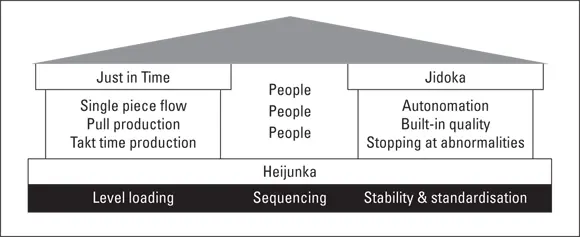You’re looking to boost the results and progress of your Lean Six Sigma program and are considering how approaches like Change Management, Agile, and Design Thinking can help.
You’re a student in business, operations or industrial engineering, for example, and you realize that Lean Six Sigma could help shape your future.
We also assume that you realize that Lean Six Sigma demands a rigorous and structured approach to understanding how your work gets done and how well it gets done, and how to go about the improvement of your processes.
Throughout the book, you’ll see small symbols called icons in the margins; these highlight special types of information. We use these to help you better understand and apply the material. Look out for the following icons:
 Keep your eyes on the target to find tips and tricks we share to help you make the most of Lean Six Sigma.
Keep your eyes on the target to find tips and tricks we share to help you make the most of Lean Six Sigma.
 Bear these important points in mind as you get to grips with Lean Six Sigma.
Bear these important points in mind as you get to grips with Lean Six Sigma.
 Throughout this book, we share true stories of how different companies have implemented Lean Six Sigma to improve their processes.
Throughout this book, we share true stories of how different companies have implemented Lean Six Sigma to improve their processes.
 This icon highlights potential pitfalls to avoid.
This icon highlights potential pitfalls to avoid.
In addition to the material in the print or e-book you’re reading right now, this book also comes with some access-anywhere goodies on the web. To view the free Cheat Sheet, go to www.dummies.com and type “Lean Six Sigma For Dummies Cheat Sheet” in the search box.
In theory, when you read you begin with ABC, and when you sing you begin with doh-ray-me (thank you Julie Andrews). But with a For Dummies book, you can begin where you like. Each part and, indeed, each chapter is self-contained, which means you can start with whichever parts or chapters interest you the most.
That said, if you’re new to the topic, starting at the beginning makes sense. Either way, lots of cross-referencing throughout the book helps you to see how things fit together and put them in the right context.
Part 1
Understanding Lean Six Sigma
IN THIS PART …
Grasp the basics of Lean and Six Sigma.
Comprehend exactly what “sigma” means and why the term is important in Lean Six Sigma.
Get a clear picture of the synergy created by merging Lean and Six Sigma, and understand the key principles underpinning the approach.
Examine the process improvement method known as DMAIC: Define, Measure, Analyze, Improve, and Control.
Get ready to begin by defining the problems you want to solve using Lean Six Sigma.
Chapter 1
IN THIS CHAPTER
 Finding out the fundamentals of both “Lean” and “Six Sigma”
Finding out the fundamentals of both “Lean” and “Six Sigma”
 Getting to grips with key concepts
Getting to grips with key concepts
 Bringing new thinking into the Lean Six Sigma mix
Bringing new thinking into the Lean Six Sigma mix
Throughout this book, we cover the tools and techniques available to help you achieve real, sustainable improvement in your organization. In this chapter, we aim to move you down a path of different thinking that gets your improvement taste buds tingling. We look at the main principles behind Lean and Six Sigma and what today’s “Lean Six Sigma” is made up of. We’ll also introduce some of the main concepts and terminology to help you on your way.
Introducing Lean Thinking
Lean thinking focuses on enhancing value for the customer by improving and smoothing the process flow (covered in Chapter 11) and eliminating waste (discussed in Chapter 10). Lean thinking has evolved since Henry Ford’s first production line, and much of the development has been led by Toyota through the Toyota Production System (TPS). Toyota built on Ford’s production ideas, moving from high volume, low variety, to high variety, low volume.
Although Lean thinking is usually seen as being a manufacturing concept and application, many of the tools and techniques were originally developed in service organizations. These include, for example, spaghetti diagrams, and the visual system used by supermarkets to replenish shelves. Indeed, it was a supermarket that helped shape the thinking behind the Toyota Production System. During a tour to General Motors and Ford, Kiichiro Toyoda and Taiichi Ohno visited Piggly Wiggly, an American supermarket, and noticed Just in Time and kanban being applied. This innovation enabled Piggly Wiggly customers to “buy what they need at any time” and avoided the store holding excess stock.
 Kanban is a Japanese word meaning “card you can see.” At the Piggly Wiggly, it was a card that provided the signal to order more stock. You’ll see kanbans turning up again in Chapter 16when we look at how Agile principles and approaches can be used to accelerate Lean Six Sigma projects.
Kanban is a Japanese word meaning “card you can see.” At the Piggly Wiggly, it was a card that provided the signal to order more stock. You’ll see kanbans turning up again in Chapter 16when we look at how Agile principles and approaches can be used to accelerate Lean Six Sigma projects.
Lean is called “Lean” not because things are stripped to the bone. Lean isn’t a recipe for your organization to slash its costs, although it will likely lead to reduced costs and better value for the customer. We trace the concept of the word “Lean” back to 1987, when John Krafcik (who later led Google’s self driving car project) was working as a researcher for MIT as part of the International Motor Vehicle Program. Krafcik needed a label for the TPS phenomenon that described what the system did. On a white board, he wrote the performance attributes of the Toyota system compared with traditional mass production. TPS:
Needed less human effort to design products and services.
Required less investment for a given amount of production capacity.
Created products with fewer delivered defects.
Used fewer suppliers.
Went from concept to launch, order to delivery and problem to repair in less time and with less human effort.
Needed less inventory at every process step.
Caused fewer employee injuries.
Krafcik commented:
It needs less of everything to create a given amount of value, so let’s call it Lean.
And just like that, Lean was born.
Bringing on the basics of Lean
Figure 1-1 shows the Toyota Production System, highlighting various tools and Japanese Lean thinking terms that we use throughout this book. In this chapter we provide some brief descriptions to introduce the Lean basics and the TPS.

© Martin Brenig-Jones and Jo Dowdall
Читать дальше

 Keep your eyes on the target to find tips and tricks we share to help you make the most of Lean Six Sigma.
Keep your eyes on the target to find tips and tricks we share to help you make the most of Lean Six Sigma. Bear these important points in mind as you get to grips with Lean Six Sigma.
Bear these important points in mind as you get to grips with Lean Six Sigma. Throughout this book, we share true stories of how different companies have implemented Lean Six Sigma to improve their processes.
Throughout this book, we share true stories of how different companies have implemented Lean Six Sigma to improve their processes. This icon highlights potential pitfalls to avoid.
This icon highlights potential pitfalls to avoid. Finding out the fundamentals of both “Lean” and “Six Sigma”
Finding out the fundamentals of both “Lean” and “Six Sigma”











